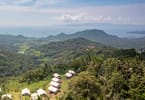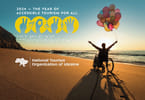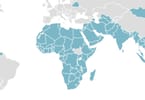The Guam Island Fiesta Tour (GIFT) introduces visi¬tors into the homes of local families for village fiesta celebrations. They are greeted with shell leis, invited to participate in cultural activities like coconut husking, talaya (cast net) throwing, and tuba (fermented coconut juice) drinking, and are treated to tables laden with authentic Chamorro cuisine. The GIFT reaches local stake-holders at a grass roots level.
The GIFT program occurs monthly in correspondence with a cel¬ebration to honor a Catholic patron saint. As local families gather for these centuries old traditions, visitors are invited to join the festivities as part of the family.
“The GIFT is a unique and intimate way to experience Chamorro culture,” said GVB General Manager Joann Camacho. “It not only shows local families that they have a stake in the visitor industry, but it displays our Chamorro culture in a way that people have not been able to experience it. We are not just telling our visitors about Guam — we’re showing them and inviting them to participate.”
RELIGIOUS ORIGIN
In the pre-contact period — before Magellan discovered Guam — there were no fi’estas. Instead, clans gathered to celebrate special events such as the harvesting of a good crop, clan contests, village events to craft a canoe, hut building, gupot åtof (roof party) or just congregating to chant and dance, tell stories and legends, give genealogy lessons, or socialize and have fun.
The Spanish Catholic missionaries introduced the system in which individual saints were honored and recognized on their patron feast date. This system was easily adapted into the Chamorro social celebrations at each of the villages. It became an occasion for families and friends from around the island to congregate for prayer and celebration.
MODERN-DAY CELEBRATIONS
Today, the villages celebrate particular saints who symbolize special powers. For example, San Roke, the patron saint of Barrigada, symbolizes a healer; San Isidro, the patron saint of Fena — and now, Malojloj — symbolizes the farmer; and Saint Jude, the patron saint of Sinajana, symbolizes the ability to perform the impossible.
Many Chamorros are known for devotion to patron saints. A nobena (special rosary) is held for nine days, culminating with the traditional village procession and festal masses. Devotees from around the island attend the village procession and festal masses in order to fulfill their promesa, or special devotion to a saint.
Promesa is a pledge of honor made when a favor asked of the saint is bestowed. Some families hold individual nobenas (religious prayers) in their homes, but for the most part, the nobena is held in the church and recited by a techa (prayer leader).
The traditional na’taotao tumano’ is a dinner served after the festal mass and procession on Saturday to which all the people who participated are invited. The people of the host village provide the na’taotao tumano’. Each family in the village brings its share of food, drinks, or money that goes toward the cost of the dinner.
Some hold their fi’esta celebration at home on a Sunday to accom¬modate relatives and friends who come to attend the Sunday festal mass. Today, these celebrations are more open.
As in other celebrations, the family prepares for the fi’esta in advance — livestock and crops are reserved, pånglao (crab) and mahongang (lobster) are caught and fattened, meats are stripped and dried for tasåhos (dried beef strips), pigs are slaughtered, and the ingredients for fritåda (a pork blood and intestine stew) are cleaned and preserved.
“We set the standard high in order to ensure our visitors get the overwhelming experience they should,” said Cultural Heritage Officer Sonja Lujan-Sellers, “Because of that, we have received outstanding feedback from everyone involved. Our visitors love it, our families enjoy teaching about our Chamorro culture, and our industry stakeholders have begun packaging GIFT as an optional tour with airlines and hotel stays.”
For reservations, visitors may contact their tour agent or Kiyoko/Rex at Lam Lam Tours at (671) 649-5314/5 or email [email protected] . Lam Lam Tours will pick up visitors at several hotels in the morning, transport them to the host family, and return to hotels at 2:00 pm.
WHAT TO TAKE AWAY FROM THIS ARTICLE:
- As in other celebrations, the family prepares for the fi'esta in advance — livestock and crops are reserved, pånglao (crab) and mahongang (lobster) are caught and fattened, meats are stripped and dried for tasåhos (dried beef strips), pigs are slaughtered, and the ingredients for fritåda (a pork blood and intestine stew) are cleaned and preserved.
- Instead, clans gathered to celebrate special events such as the harvesting of a good crop, clan contests, village events to craft a canoe, hut building, gupot åtof (roof party) or just congregating to chant and dance, tell stories and legends, give genealogy lessons, or socialize and have fun.
- “It not only shows local families that they have a stake in the visitor industry, but it displays our Chamorro culture in a way that people have not been able to experience it.






















